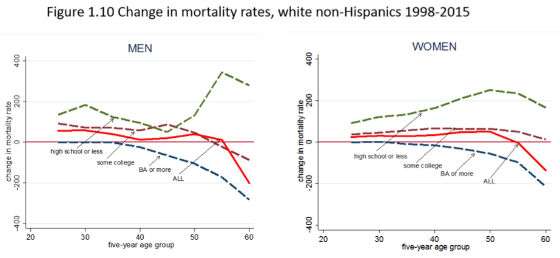Poor White Americans Are Dying of Despair
In contrast, the mortality rate for college-educated whites continues to fall.

As perfect storm of woes have hit poor American whites with high school or less educations and they are dying as a result. This is the sobering conclusion of new analysis by Princeton economists Anne Case and Angus Deaton. The new Brookings Institution paper extends their 2015 findings that mortality rates for mid-life Americans have been increasing since the turn of the millennium. In their earlier work, they refused to speculate about why the death rate among poor middle-aged whites was rising. In their new work, they are no longer reticent: Many poor white Americans are dying of despair.
How bad is it? Consider that in 1999, the mortality rate for whites age 25-29 with a high school education or less (LEHS) was 146 per 100,000. By 2015 that had increased to 266 per 100,000. For those age 45-49, the rate had increased from 491 in 1999 to 620 per 100,000 in 2015. Meanwhile mortality rates for all age groups of blacks and hispanics continued to fall during that period. Among whites, the mortality gap between those with a college degree and those without widened. For example, Case and Deaton report: "The mortality rate for men with less than a BA aged 50-54, for example, increased from 762 per 100,000 to 867 between 1998 and 2015, while for men with a BA or more education, mortality fell from 349 to 243."

What is killing poor less educated whites? Deaths from despair are largely increasing due drug overdoses, suicides, and alcoholic-related liver mortality. In addition, Case and Deaton note that declines in heart disease and cancer have also slowed considerably. They suggest that increases in obesity and diabetes can also account for some the increase in mortality among whites. Although Case and Deaton don't mention it, the incidence of cancer is associated with obesity.
They report that this increase in mortality among less educated American whites began in the southwest, where it was centered in 2000, and then spread first to Appalachia, Florida and the west coast by the mid-2000s, and is now country-wide. It is now both an urban and a rural epidemic.
So why are less educated whites poisoning themselves to death with drugs, alcohol and sugar? They outline a process of cumulative deprivation beginning after the 1970s that is rooted in the steady deterioration in job opportunities for people with low education. Men with less economic prospects became less marriageable resulting in single-motherhood becomingthe norm. Declining economic opportunities also coincided with the erosion of traditional community structures that provided meaning and stabilty for many poor folks. Case and Deaton cite data suggesting that "half of the men who are out of the labor force are taking pain medication, and two thirds of those take prescription painkiller, such as opioids."
Case and Deaton assert that reversing this increase in white working class mortality will not be easy, but suggest that one first step toward ameliorating this sad situation would be to rein in the proliferation of opioid prescriptions.
For more background on these trends see my article "Stuck" in which I visit McDowell County, WV from which my father's family hails.

Show Comments (131)